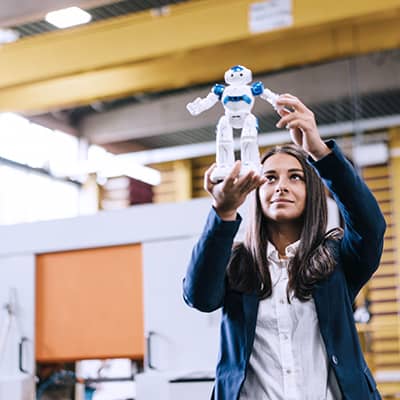The Role of Artificial Intelligence in the Future of Education
Gone are the days of visiting the library to photocopy a few pages from an encyclopedia for a school project. As generations of children grow up with technology at their fingertips, we live in a world where the internet is their primary source of information, education, and entertainment. A recent survey found that children in the U.S. aged between eight and 12 spend almost five hours a day looking at screens, while teenagers are clocking nearly seven hours a day of screen time – and that’s not counting the time they spend doing schoolwork. Hours spent learning from chalkboards in physical classrooms has also reduced significantly since the start of the COVID-19 pandemic, and the ensuing social restrictions and lockdowns.1 As technology and society continue to evolve and develop, the way we learn will also continue to change, for children and adults alike.
“My hope is that by 2030, most of humanity will have ready access to health care and education through digital agents.” 2
– Gabor Melli, VP of artificial intelligence and machine learning at Medable and former senior director of engineering at Sony PlayStation
The rapid advancement of technologies such as artificial intelligence (AI), machine learning (ML), and robotics impacts all industries, including education.3 If the education sector hopes to utilize AI’s full potential for everyone, the focus should be to continue exposing the next generation to AI early on and utilizing the technology in the classroom. Teachers are already finding that many students use AI through social media and are, therefore, open to its educational applications.4
There’s also a great professional need for these abilities. “The U.S. Bureau of Labor Statistics sees strong growth for data science jobs skills in its prediction that the data science field will grow about 28 percent through 2026,” says Bernard Schroeder, senior contributor for Forbes. With increased technology comes increased data operations and analysis sophistication, as well as more AI. These changes will ultimately increase the demand for data scientists and other AI specialists.5
If you’re interested in learning how AI disrupts the business world, these online short courses with GetSmarter could be a good starting point.
The role of artificial intelligence in education
The rapid advancement of technologies such as AI, ML, and robotics impacts all industries, including education.
Global Market Insights Inc. predicts that the AI education market could have a market value of $20 billion by 2027.6 The industry growth is good news, as AI can ultimately reduce the burden on teachers across the globe.
However, some educators fear that in the future, AI technology might replace the role of the teacher altogether. Fortunately, it doesn’t look like teachers are at risk of being replaced by robots anytime soon. While AI programs can teach students literacy or math, the more complex impartation of social and emotional skills will remain in the domain of humans.7
How artificial intelligence is currently used in education
Because AI is computer-based, it can be connected to different classrooms all over the world.
How technology is used in classrooms has changed significantly in response to COVID-19. Rather than teaching in front of a classroom full of students, lockdowns forced many educators across the globe to teach remotely, from their homes. Edtech company Promethean surveyed teachers and learned that 86 percent thought AI should be an important part of education.
Using AI in education holds many benefits for both students and teachers:8
- Learning resources can be accessed from anywhere, at any time
- Time-consuming, tedious tasks such as record keeping or grading multiple-choice tests can be completed through AI automation
- Frequently asked questions can be answered through chatbots
- AI tutors and chatbots can be available to answer questions at any time
- Learning can be tailored and adapted to each student’s goals and abilities through personalized programs
Examples of AI in education

AI is already being applied successfully in several educational instances and improves learning and student development, as well as educators’ performance.
Let’s take a closer look at a few applications:
- Emotional well-being: A child’s emotional state affects how well they can focus, engage, and stay motivated to learn. Virtual schools can be just as effective as face-to-face learning environments when they use emotion recognition technology. Thanks to gamification, learning can also be adjusted to be fun. Furthermore, AI can determine where students struggle and help them to improve and, ultimately, excel.9
- Spotting and filling the gaps: AI can identify the gaps in teachers’ presentations and educational material, and suggest adjustments where needed.10
- Children working alongside AI: Nao is a humanoid robot that talks, moves, and teaches children everything from literacy to computer programming. Nao engages children in learning science, technology, engineering, and mathematics (STEM) subjects, and provides a fun coding lab for students. This introduction to basic coding allows students to instruct the robot to perform specific tasks, such as using hand gestures or doing choreographed dances. This way, students get the opportunity to become familiar with telling a robot (or program) what to do, thereby preparing them for a future where robots and humans work together.11
The following educational applications harness the power of AI to improve learning in students of all ages:12
- Thinkster Math: Thinkster Math is a tutoring app that blends the math curriculum with a personalized teaching style. The app uses AI and ML to visualize how students think as they work through a math problem. This allows the tutor to quickly spot areas in the child’s thinking and logic that need work. It then assists them by giving them immediate, personalized feedback.
- Brainly: Students can ask homework questions on this education platform and receive automatic, verified answers from fellow students. Brainly, which ultimately helps students learn faster, uses ML algorithms to filter out spam.
- Content Technologies, Inc. (CTI): This AI company uses deep learning to create customized learning tools for students. One of these tools, JustTheFacts101, makes it easy for teachers to import syllabi into a CTI engine. The machine then uses algorithms to create personalized textbooks and coursework based on core concepts. Cram101 is another example of an AI-enhanced offering, where any textbook can be turned into a smart study guide, providing bite-sized content that’s easy to learn in a short space of time. The tool even produces multiple-choice questions, saving students time and helping them learn more effectively.
- Gradescope: This platform makes grading less time-consuming (teachers’ grading time is reduced by 70 percent or more) and provides student data that can indicate where they need additional assistance.
- Duolingo: With more than 120 million users worldwide, Duolingo has a broad audience that reaches beyond the classroom. It offers 19 languages and helps anyone using the app to learn a foreign language, building their skills over time. With quizzes and other tests, the program adapts to each user’s abilities to offer new challenges.
How AI is set to change the education market
The World Economic Forum estimates that, by 2025, a large proportion of companies will have adopted technologies such as ML. They strongly encourage governments and educational institutions to focus on rapidly increasing related education and skills, focusing on both STEM and non-cognitive soft skills to meet the impending need. Advances in technology will cause major disruptions in the workforce, as automation could replace up to 50 percent of existing jobs in the U.S. alone, Microsoft reported.13 The Microsoft report continues, suggesting students will need to have mastered two facets of this new world by the time they graduate.
They need to:
- Know how to utilize ever-changing technology, such as AI, to their advantage
- Understand how to work with other people in a team to problem-solve effectively
Preparing students to work alongside AI in the future can start early. As many children are already comfortable with digital technology before entering school, it’s essential to teach them the skills to thrive in a digital workplace. The workforce of the future has its foundation in the now.
In the Oxford Artificial Intelligence Programme, you’ll gain an understanding of AI and learn how it can be best implemented in your workplace. Expand your knowledge in this disruptive and transformative industry, and use AI to advance your business.
- 1 (Nd). ‘Effects of technology on children during a pandemic’. Retrieved from Regis College. Accessed December 13, 2021.
- 2 Anderson, J. & Rainie, L. (Dec, 2018). ‘Artificial intelligence and the future of humans’. Retrieved from Pew Research Center.
- 3 Cox, A. (Jan, 2021). ‘Exploring the impact of artificial intelligence and robots on higher education through literature-based design fictions’. Retrieved from International Journal of Education Technology in Higher Education.
- 4 Lieberman, M. (May, 2020). ‘How educators can use artificial intelligence as a teaching tool’. Retrieved from Education Week.
- 5 Schroeder, B. (Jun, 2021). ‘The data analytics profession and employment is exploding – three trends that matter’. Retrieved from Forbes.
- 6 (Jun, 2021). ‘AI in education market revenue to cross $20B by 2027; Global Market Insights, Inc.’. Retrieved from PR Newswire.
- 7 Bushweller, K. (Jan, 2020). ‘Teachers, the robots are coming. But that’s not a bad thing’. Retrieved from EdWeek.
- 8 Hunt, S. (Oct, 2021). ‘How AI is being used in education’. Retrieved from Datamation.
- 9 Chan, M. (Feb, 2021). ‘This AI reads children’s emotions as they learn’. Retrieved from CNN.
- 10 Marr, B. (Nd). ‘How is AI used in education – real world examples of today and a peek into the future’. Retrieved from Bernard Marr & Co. Accessed December 15, 2021.
- 11 (Nd). ‘The future of education is NAO’. Retrieved from SoftBank Robotics. Accessed on December 15, 2021.
- 12 Lieberman, M. (May, 2020). ‘How educators can use artificial intelligence as a teaching tool’. Retrieved from Education Week.
- 13 (Oct, 2018). ‘The Class of 2030 and Life-Ready Learning: The Technology Imperative’. Retrieved from Microsoft.
